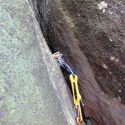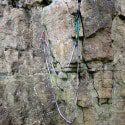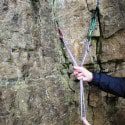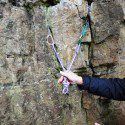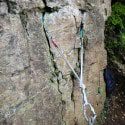Once you have been tempted outdoors and begin leading sport routes, you soon realise that this type of climbing is 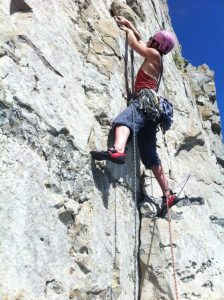 quite restrictive. You can only climb where there are routes with bolts. In order to develop your skills and experience more adventurous climbs on mountain crags and sea cliffs, you will have to learn to trad lead climb.
quite restrictive. You can only climb where there are routes with bolts. In order to develop your skills and experience more adventurous climbs on mountain crags and sea cliffs, you will have to learn to trad lead climb.
Trad climbing involves placing your own protection on natural rock in the form of spikes, threads, nuts, camming devices and hexes. This immediately causes problems as to what to buy to start you off.
You can learn by trial and error, or go out climbing with more experienced friends, or read lots of books and check out the internet.
The best way to learn, however, is to book on a trad lead course with an instructor with a minimum qualification of a Mountain Instructor Award who is a member of the Association of Mountaineering Instructors.
A good instructor will save you money in the long run as you will learn more on a 2/3 day course than it would take many years of experience to acquire including:
- Climbing venues, where to climb in your local area, the UK, Europe etc.
- Setting safe belays.
- Lead belaying using double ropes.
- Gear selection and placement.
- Racking up including selecting your own gear.
- The latest equipment.
- Route finding using the guide book and route finding on the climb.
- Gaining the confidence to lead above protection – learning to trust your own placements.
- How to get off – walking off and/or abseiling.
- Simple rescue techniques.
- Warming up and cooling down techniques.
- How and when to move up the grades.
If you decide to go ahead and go it alone the best way to start is mock leading. You will need a minimum of a set of nuts, 3 or 4 cams (or hexes) and a selection of slings. You can only mock lead at crags where you can set up a bottom rope on a solid belay. You will also need 2 single ropes, one for the bottom rope and one for the mock lead rope. It is always better if you can have 2 belayers as it makes the mock leading more realistic and is good practice for the lead belayer.
When you rack up for a trad lead you need to ensure you have enough gear loops on your harness for the extra equipment you will carry.
Camming Devices: it is best to have a range from small to medium large (the larger cams are more suited to gritstone) and arranged on individual snap-links, colour co-ordinated if you desire.
Hexes: again small to large on long tapes on individual karabiners.
*It is not usual to carry both cams and hexes, climbers usually have a preference. Hexes are cheaper, but cams have a greater range for placements, are more flexible and quite forgiving, but need more practice to make them user-friendly.
Slings: 5 or 6 at 120cm for extending gear (with a combination of screw-gate and snap-link karabiners), particularly if you’re using a single rope and for spikes and threads. 1 at 240cm for big blocks or equalising anchors that are a long way apart. Some climbers carry them on their gear loops, shortened by twisting, others carry them doubled across their bodies.
Belay Device: preferably carried on the central loop at the back of the harness.
Nut key/runner remover: carried at the back of your gear, useful for cleaning runner placements and threading slings.
Prussik loops: thin cord used for added protection when abseiling and simple rescue techniques.
How you arrange your gear is entirely up to you, but it must be logical, suited to the individual and in such a way that it is easy to remember and access.
Before you leave the ground, you need to have a good understanding of how your gear works, and one of the best ways of doing this is to create belays. You can usually put nuts and hexes into flaring vertical cracks and with practice into horizontal cracks and breaks. Cams are designed to fit in parallel and flared cracks/breaks, but to recognize a good placement requires practice and experience.
How to create a typical belay:
- Place a bombproof nut or cam.
- Place a bombproof cam or nut.
- Equalise in the direction of force
- Link the gear with a 120 cm sling
- Maintaining the tension
- Tie a figure of 8 knot
- Attach yourself to the belay using a screw-gate karabiner with a clove hitch.
It is worth weighting the belay to see whether the gear holds/moves/comes out to see how effective it is – so long as you are on the ground if the belay fail you are completely safe.
Slings are also useful for spikes and threads – natural protection that is often the most reliable. A spike allows you to drape a sling over it and if clipped long it shouldn’t lift off, but it is worth checking that the spike is solid with no tell tale cracks around it. A thread is created by a natural bar of rock connected above and below, with often limited space behind it where you have to fiddle a sling through to create a very solid runner.

